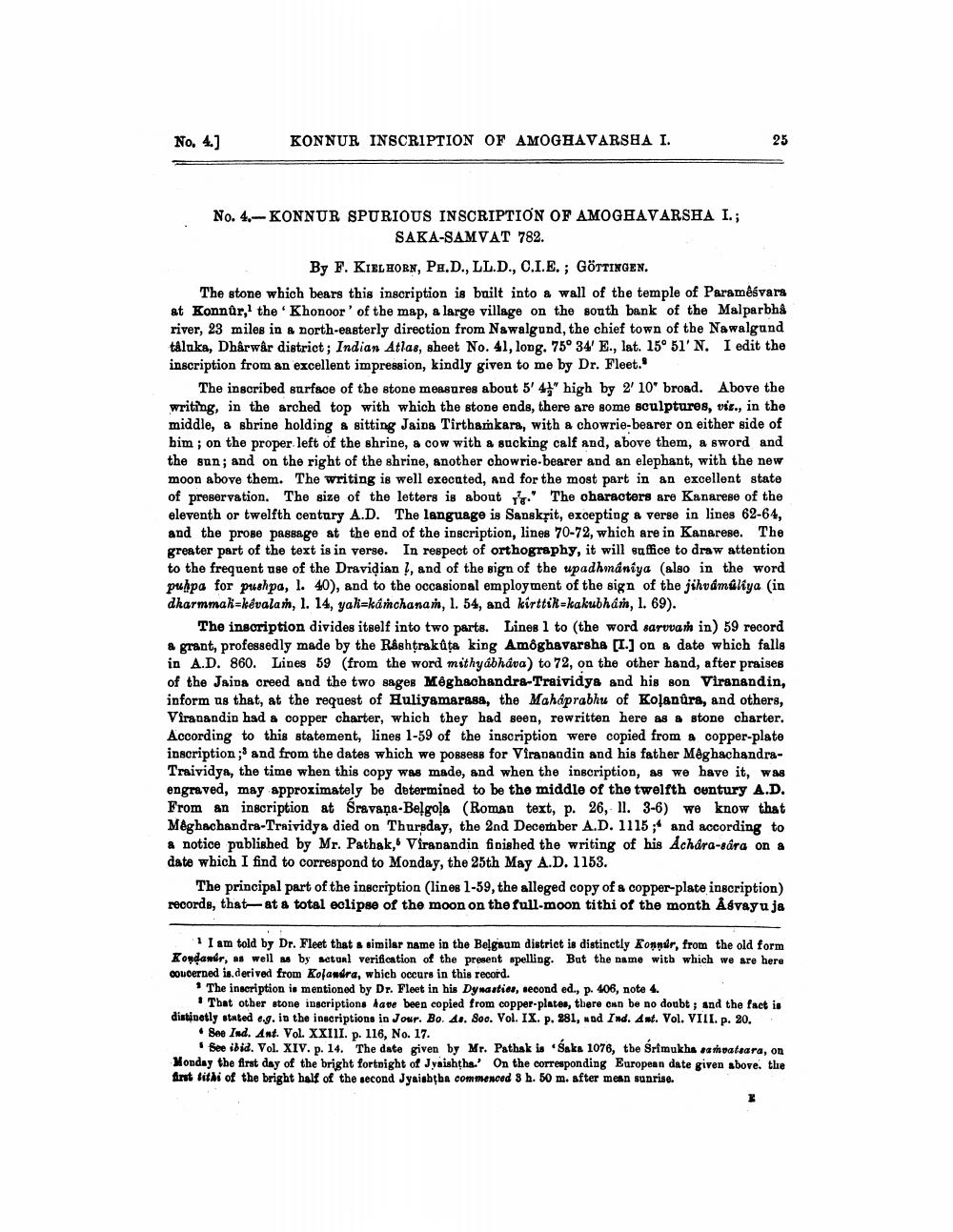________________
No. 4.]
KONNUR INSCRIPTION OF AMOGHAVARSHA I.
25
No. 4.-KONNUR SPURIOUS INSCRIPTION OF AMOGHAVARSHA I.;
SAKA-SAMVAT 782.
By F. KIEL HORN, PA.D., LL.D., C.I.E.; GÖTTINGEN. The stone which bears this inscription is built into a wall of the temple of Paramêśvara at Konnûr, the Khonoor' of the map, a large village on the south bank of the Malparbha river, 23 miles in a north-easterly direction from Nawalgund, the chief town of the Nawalgund tálaka, Dharwar district; Indian Atlas, sheet No. 41, long. 75° 34' E., lat. 15° 51' N. I edit the inscription from an excellent impression, kindly given to me by Dr. Fleet."
The inscribed surface of the stone measures about 5' 4" high by 2' 10" broad. Above the writing, in the arched top with which the stone ends, there are some sculptures, viz., in the middle, a shrine holding & sitting Jaida Tirthamkara, with a chowrie-bearer on either side of him ; on the proper.left of the shrine, a cow with a sucking calf and, above them, a sword and the sun; and on the right of the shrine, another chowrie-bearer and an elephant, with the new moon above them. The writing is well execated, and for the most part in an excellent state of preservation. The size of the letters is about 1. The characters are Kanarese of the eleventh or twelfth century A.D. The language is Sanskrit, excepting a verse in lines 62-64, and the prose passage at the end of the inscription, lines 70-72, which are in Kanarese. The greater part of the text is in verse. In respect of orthography, it will soffice to draw attention to the frequent use of the Dravidian !, and of the sign of the upadhmaniya (also in the word puhpa for pushpa, l. 40), and to the occasional employment of the sign of the jihvámúliya (in dharmmah=kévalan, 1. 14, yahirkanchanań, 1. 54, and kirttikukakubhán, 1. 69).
The inscription divides itself into two parts. Lines 1 to (the word sarvvar in) 59 record a grant, professedly made by the Rashtrakata king Amoghavarsha [I.] on a date which falls in A.D. 860. Lines 59 (from the word mithyabhava) to 72, on the other hand, after praises of the Jains creed and the two sages Méghachandra-Traividya and his son Viranandin, inform us that, at the request of Huliyamarasa, the Maháprabhu of Kolanûra, and others, Viranandin had a copper charter, which they had seen, rewritten here as a stone charter. According to this statement, lines 1-59 of the inscription were copied from a copper-plate inscription;' and from the dates which we possess for Virapandin and his father MeghachandraTraividya, the time when this copy was made, and when the inscription, as we have it, was engraved, may approximately be determined to be the middle of the twelfth ountury A.D. From an inscription at Sravana-Belgols (Roman text, p. 26, 11. 3-6) we know that Meghachandra-Traividya died on Thursday, the 2nd December A.D. 1115;" and according to a notice published by Mr. Pathak, Virapandin finished the writing of his Achara-gara on a date which I find to correspond to Monday, the 25th May A.D. 1153.
The principal part of the inscription lines 1-59, the alleged copy of a copper-plate inscription) records, that-at & total eclipse of the moon on the full-moon tithi of the month Åsvayu ja
"I am told by Dr. Fleet that a similar name in the Belgaum district is distinctly Konnur, from the old form Kondamir, as well as by actual verification of the present spelling. But the name with which we are here coucerned is derived from Kolambra, which occurs in this record.
• The inscription is mentioned by Dr. Fleet in his Dynasties, second ed., p. 406, note 4.
"That other stone inscriptions have been copied from copper-plates, there can be no doubt ; and the fact is distinctly stated eg. in the inscriptions in Jour. Bo. As. Soo. Vol. IX. p. 281, and Ind. Ant. Vol. VIII. p. 20.
• See Ind. Ant. Vol. XXIII. p. 116, No. 17.
Bee ibid. Vol. XIV. p. 14. The date given by Mr. Pathak is 'Saks 1076, the Srimukha samvatsara, on Monday the first day of the bright fortnight of Jyaishtha.' On the corresponding European date given above, the first tithi of the bright half of the second Jyaishțba commenced 3 h. 50 m. after mean sunrise.




